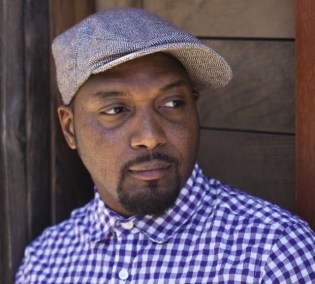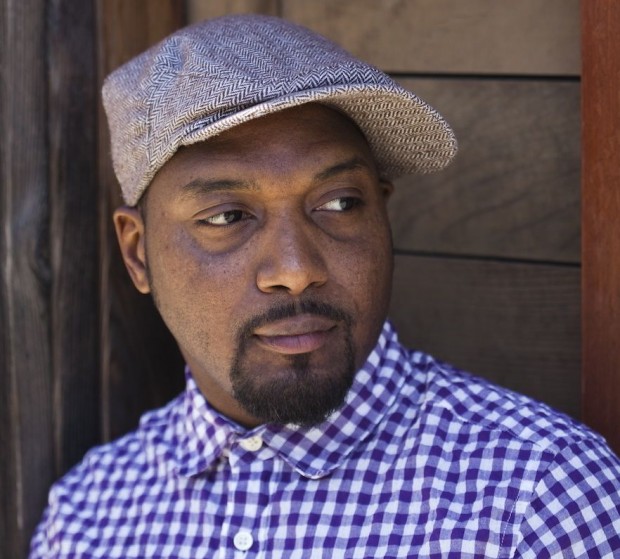
Photo by Jennifer Martine.
Chef and food justice activist Bryant Terry’s latest book, The Inspired Vegan: Seasonal Ingredients, Creative Recipes, Mouthwatering Menus, may look like a simple cookbook, but it’s also much more than that. In it, Terry has included personal reflections on the history, music, and politics that shaped his interest in healthy, whole foods, as well as the cultural influences that inspired the recipes.
Terry wrote the book before and immediately after his daughter was born and his intention, he says, was to create a snapshot of who he was at the time. But he also hopes the book inspires people to connect with their food. He’s included a “basics” section, but if you’re ready to take on some jerk tempeh, he’s got you covered, too. We spoke with Terry recently about the book, as well as his broader work to inspire healthy eating within communities of color, and change the food system from the bottom-up.
Q. What are you trying to achieve with this book, and whom do you hope to reach?
A. I think it’s important for me to present animal product-free food that is sumptuous and interesting, and comforting. If it isn’t flavorful and delicious, I don’t care about it.
My goal isn’t to convert people into vegans. I see vegan food as a tool for addressing the public health crisis that many communities are dealing with, particularly African-American, Latino, Native American, and even some of the more recent Asian immigrant populations.
The micro-essays and stories are my way of emphasizing the importance of remembering your own legacies. When I travel the country, I ask, “How many of your parents or grandparents have gardens?” At least three-quarters of the people in the room, in every audience [put] their hands up. Whether it’s in Appalachia or the urban South, they have this connection with growing and eating healthful food.
I think it’s great that people are getting into food, but at the same time, I think there’s a way in which this cult of the celebrity chef disempowers everyday people. I’ve heard from so many people who feel intimidated because they didn’t go to cooking school and they’ve never had a restaurant. One of the things I strive to do is help bring out people’s inner chef.
Q. How did you transition from working with a project called b-healthy! a decade ago to your current work, which seems centered around writing books and speaking?
A. When I started b-healthy! in 2001, I was doing grassroots activism in New York City with young people from the lower economic strata. Our goal was to radicalize and empower them to be leaders in the food justice movement.
I see the work I do now as equally political because I understand that in order to transform communities, we need to help people understand the importance of consuming healthful, fresh food. So many people are disconnected from it, and if they don’t understand the positive impact it can have on their lives — why would they fight for it?
I see this as a form of activism, trying to change people’s hearts and minds through their stomachs, but with the goal of eventually politicizing them, [so they] understand that the issues aren’t simply about personal choice. That’s important, but there also are larger, structural inequalities in place.
Q. How do you reach out to the communities you’ve mentioned?
A. My books have been a tool for bringing more people into this movement — specifically, communities of color, and more specifically, African-American communities. I focus on that community not only because I’m African-American, but because I think it’s important to realize that if we address the most deeply impacted communities, then it’s such a great opportunity for thinking about healing the food system as a whole, from the bottom-up.
It’s also important to emphasize that I’m standing on the shoulders of my ancestors. I don’t see myself doing anything new — I’m kind of repackaging older ideas. All the ways in which people are celebrating this return — whether it’s to gardening, pickling, or preserving — so often the stories that are told are [about] young, educated white folks.
My grandparents were pickling and preserving and canning. These were just ways that they lived their lives — it wasn’t anything special. They had urban farms, they had community gardens in their neighborhood, they were bartering surplus produce. People were growing tomatoes on their front porches.
When we think about the most impacted communities, if we look back [at what they ate], it’s all healthful, sustainable food. The foundation of African-American cuisine is collard greens, dandelion greens, mustard greens, kale, butter beans, black-eyed peas, and sweet potatoes. These are foods that many African-Americans have been eating for generations, but it’s cooler to just talk about the comfort foods [fried chicken, etc.] and make that the whole of the cuisine. That’s not the case, and I think even African-Americans have forgotten.
Q. Healthy food is often viewed as expensive and elitist. Do you get that reaction at all, and how do you respond?
A. There are a number of concerns that come up frequently. There’s this idea that eating healthfully and sustainably is too expensive, that it’s too time-consuming, and that it’s resource-intensive — that people don’t have the tools for making home meals. I understand, to a certain extent, the reality of all those concerns.
One thread throughout my work has been community building, and encouraging people to approach these issues with family members, friends, etc. It goes back to what Anna Lappe and I were doing with our first book [Grub: Ideas for an Urban Organic Kitchen] and Grub parties — not dinner parties with wine and jazz, but encouraging people to gather with friends and family and collectively buy food together. Obviously if you are pooling your resources, you don’t have to spend all your disposable income on the food yourself. Making meals collectively addresses the issue of how time-consuming it is, but most importantly, you’re having exchanges with people.
Q. Do you have thoughts on the term “food desert”?
A. I think it can be useful in helping people understand the way many communities have very few options for healthful, affordable food. But in some ways, “food desert” kind of naturalizes the problem — like it’s just been this way. And [it doesn’t take into account] the role of white flight, and the industrialization, and all these different system-wide trends that impact the way in which many communities — whether it’s food or jobs or infrastructure — deteriorate.
That term also ignores the reality that there are people growing food in these communities. Throughout the country, [new] immigrant populations — whether they’re from Latin America or Southeast Asia or Africa — understand the importance of having a connection with their cultural foodways. People are growing their herbs and fresh vegetables and fruits from their homeland and bringing it into this new context.
Q. Is veganism growing in the African-American community?
A. Yes, it is. Not that it hadn’t been happening before. There’s been this consistent thread of African-American vegetarians and vegans, and I think their voices aren’t often heard. But in terms of everyday folks, I feel like there is this rise in the number of people who are embracing vegetarianism and veganism.
These people are dealing with death and sickness in their families; they’re looking for solutions, and they’re tired of being on meds. People are understanding the limited role that a lot of pharmaceuticals play in healing, because they’re often just treating symptoms. They are becoming more invested in healing themselves and their families.
I remember when Vegan Soul Kitchen came out, the litmus test of the book’s success for me was the innumerable emails that I got from people who identified as African-American and were dealing with diabetes or other chronic illnesses. They had heard about the role that veganism can play, but then they’d finally found some food that harkened back to their own culture and it empowered them to embrace it. This was in 2006, and since then, I’ve heard more stories, and met more individuals who, if not wholeheartedly embracing the vegan diet, are certainly moving meat from the center toward the margins of their plate.




